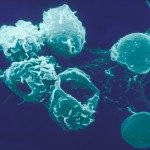Link to Pubmed [PMID] – 32651476
Link to DOI – 10.1038/s41385-020-0320-8
Mucosal Immunol 2020 Sep; 13(5): 732-742
ILCs and T cells are closely related functionally but they significantly differ in their ability to circulate, expand, and renew. Cooperation and reciprocal functional regulation suggest that these cell types are more complementary than simply redundant during immune responses. How ILCs shape T-cell responses is strongly dependent on the tissue and inflammatory context. Likewise, indirect regulation of ILCs by adaptive immunity is induced by environmental cues such as the gut microbiota. Here, we review shared requirements for the development and function of both cell types and divergences in the orchestration of prototypic immune functions. We discuss the diversity of functional interactions between T cells and ILCs during homeostasis and immune responses. Identifying the location and the nature of the tissue microenvironment in which these interactions are taking place may uncover the remaining mysteries of their close encounters.

